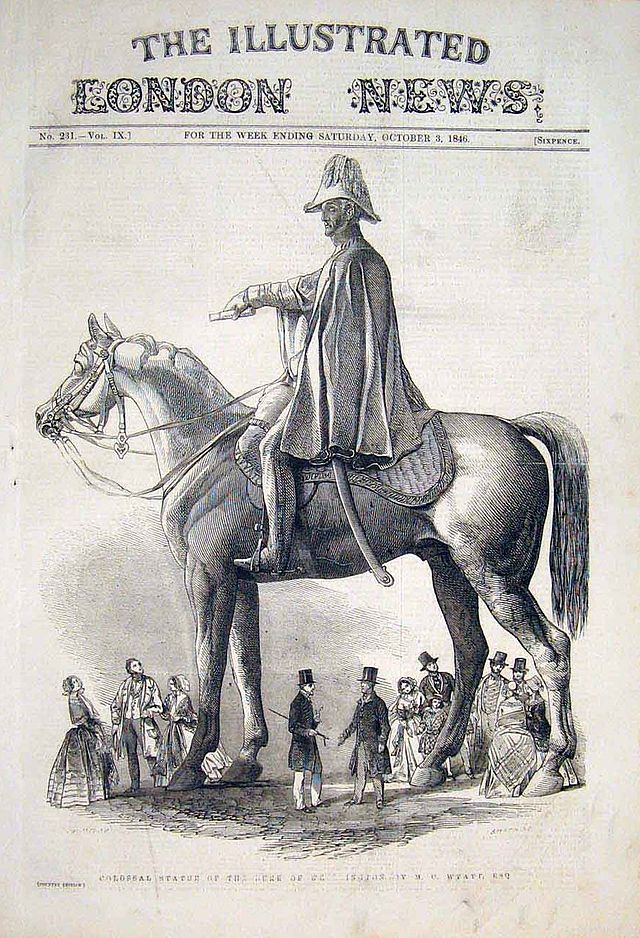Erected in 1912, the group depicts the winged goddess Victoria riding a four-horse chariot, also symbolic of triumph. It is by Adrian Jones, the army vet who made a dramatic career change to become the foremost sculptor of horses in the Edwardian era.
 The horses leap and rear with tremendous vitality, and the boy driver (modelled on the son of Lord Michelham, who donated funds for the statue) leans forward excitedly with the reins. The model for Victoria was Beatrice Stewart, who also sat for Sargent, Augustus John and others (and later was the young Patrick Leigh Fermour's longsuffering landlady).
The horses leap and rear with tremendous vitality, and the boy driver (modelled on the son of Lord Michelham, who donated funds for the statue) leans forward excitedly with the reins. The model for Victoria was Beatrice Stewart, who also sat for Sargent, Augustus John and others (and later was the young Patrick Leigh Fermour's longsuffering landlady).
There seems to have been a move to rebrand the statue as 'Peace descending on the Quadriga of War' but it is no such thing - Victoria and her Greek equivalent Nike flew around battlefields dishing out laurel wreaths to heros, not trying to bring reconciliation and harmony like some UN arbitration committee.
The statue was erected in memory of King Edward VII, who had (when Prince of Wales) been impressed by a plaster sculpture of a quadriga entitled 'Triumph' by Adrian Jones at the Royal Academy exhibition in 1891.
The history of the Wellington Arch is a text book account of the egomania, vendettas and political expediencies that often form the background to public sculpture projects.
The arch was designed by Decimus Burton in 1825 as a northern gateway to Buckingham Palace, standing right opposite the grand entrance to Hyde Park next to Apsley House. The original design was much more heavily ornamented and had a quadriga on top, but most of the folderols were axed by the committee brought in to control the stratospheric costs of the Prince Regent's expansion of his new palace.
For years the arch had nothing on top, until a cabal of top politicians led by the Duke of Rutland finagled the Wellington Memorial Committee into agreeing to a monster equestrian statue of their hero to be placed on it. The idea was that it was diagonally opposite the Duke's London home so it would be nice for the old boy to look out on it.
 The statue was designed by the Duke of Rutland's protegee Matthew Cotes Wyatt. When it was put in place in 1846 it was greeted with jeers, partly because its size was completely out of scale with the arch but mainly because it was hideous. Attempts to remove it were, however, blocked by the Duke who threatened to resign all his public appointments if it was touched. Even Queen Victoria backed off.
The statue was designed by the Duke of Rutland's protegee Matthew Cotes Wyatt. When it was put in place in 1846 it was greeted with jeers, partly because its size was completely out of scale with the arch but mainly because it was hideous. Attempts to remove it were, however, blocked by the Duke who threatened to resign all his public appointments if it was touched. Even Queen Victoria backed off.
Eventually, after the Duke's death, the arch itself came to be seen as a traffic obstruction and in 1883-5 it was moved to its current site. The statue was taken to Aldershot where it would be better appreciated.
Once again controversy raged over a replacement, eventually satisfactorily resolved with the Quadriga we see today.



1 comment:
I don't believe olive branches are normally associated with the Roman Victoria... In this instance it probably means "we can have peace now that we've knocked the stuffing out of you". Even so, the only thing more presumptuous than branding four horses and a boy charioteer as the personification of war is the idea that the ensemble, and by extension the country's imperialist past, not only could but ought to be masqueraded as a tribute to peace and good intentions. Condemning your history is not the same thing as rewriting it, which often doesn't work anyway.
Post a Comment